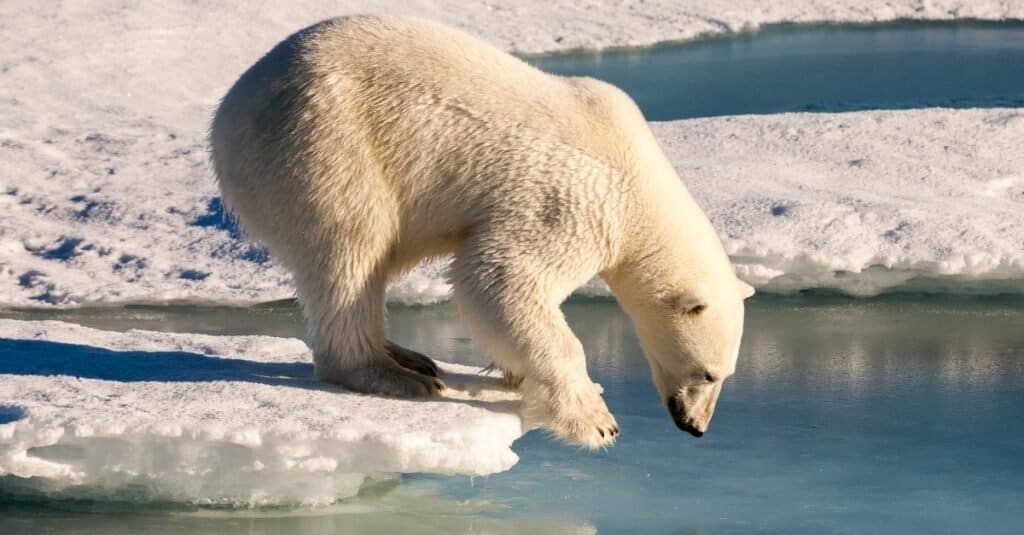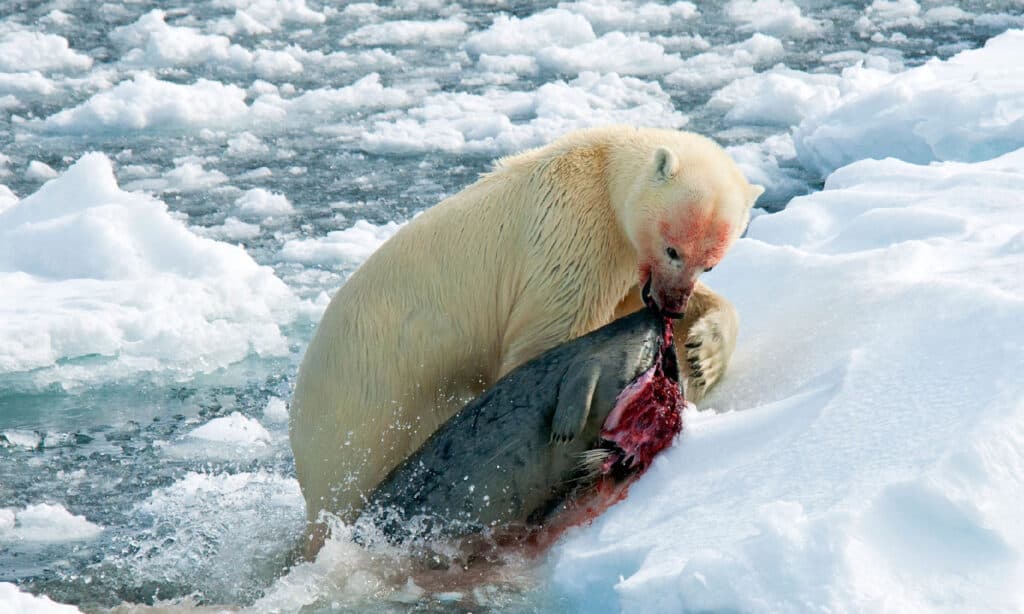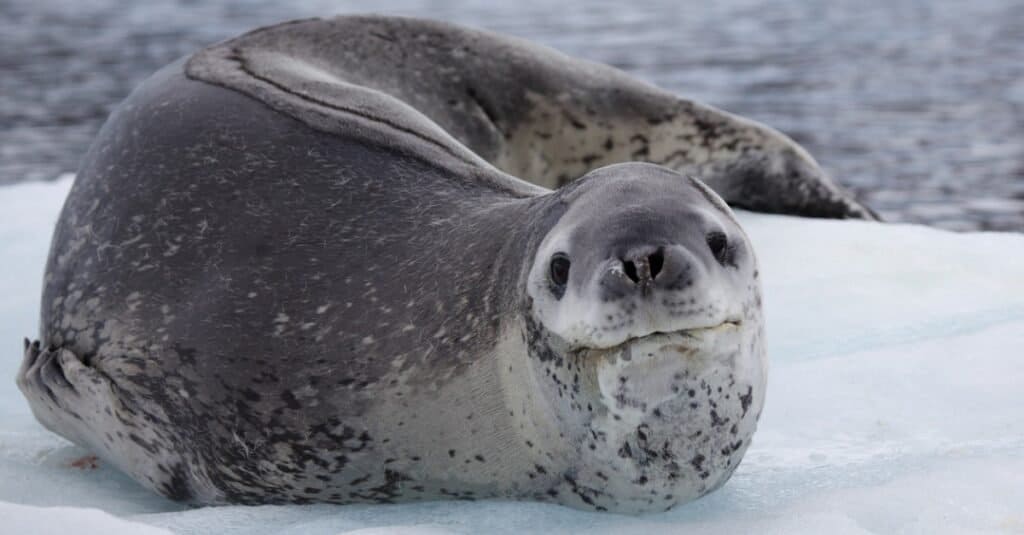Leopard seals and polar bears are animals that don’t have much in common, except for a few facts, including that they both live in cold habitats. Even this is debatable since they live in opposite parts of the world! Highlighting their differences might help you learn more about these two species.
Let’s find out how we can distinguish between them!
Comparing Leopard Seal vs Polar Bear
| Leopard Seal | Polar Bear | |
|---|---|---|
| Size | Length: 7.9 – 11.5 feet Weight: 440 – 1,300 pounds | Length: 7.8 – 9.8 feet (males); 5.9 – 7.8 feet (females) Weight: 770 – 1,500 pounds (males); 330 – 570 pounds (females) |
| Appearance | – Thin coat; dark gray or black head and back; – Big snout, rounded head, large mouths, flippers on all four feet; – Black spots around the white parts; – White or light gray around the belly; – 32 teeth | – Elongated body, long skull, and nose, small ears and tail, large feet; – Polar bears have an underlayer of dense fur and an outer layer of guard hairs (2 – 6 inches long); – An excellent sense of smell and swimming abilities; – 42 teeth |
| Classification | Kingdom: Animalia Phylum: Chordata Class: Mammalia Order: Carnivora Family: Phocidae Genus: Hydrurga Species: Hydrurga leptonyx | Kingdom: Animalia Phylum: Chordata Class: Mammalia Order: Carnivora Family: Ursidae Genus: Ursus Species: Ursus maritimus |
| Distribution and Habitat | – Primarily inhabiting the Antarctic pack ice; – Spotted in Australia, New Zealand, South America, South Africa | – The sea ice covering the continental shelf; – The Arctic inter-island archipelagos, polynyas, the Arctic ice pack, northern Canada, Greenland, Alaska, Hudson Bay |
| Predators and Threats | Killer whales (orcas), sharks, climate change | No natural predators; threatened by climate change, pollution, human-bear interaction, relatively slow rate of reproduction |
| Behavior | Solitary, vocal, territorial | Solitary, non-territorial |
| Lifespan | 20 – 24 years | 20 – 30 years (most individuals don’t get older than 15-18 years) |
| Conservation Status | Least Concern | Vulnerable |
The Key Differences Between Leopard Seals and Polar Bears
Both the leopard seal and polar bear are ferocious predators in their habitats. However, they are very different in terms of size, appearance, behavior, and diet, among other factors. Let’s learn more about the differences between the leopard seal and the polar bear!
Leopard Seal vs Polar Bear: Size

Male polar bears can weigh up to 2,209 pounds.
©Mario_Hoppmann/Shutterstock.com
Leopard seals and polar bears have similar sizes, although leopard seals can be slightly longer while polar bears are usually heavier.
Suppose we consider their average length and weight. Leopard seals are only a few feet longer than polar bears, that is if we compare leopard seals with male polar bears. Female polar bears are shorter than both, reaching about 7.8 feet in length.
As for their weight, male polar bears can be much heavier than leopard seals! While female polar bears weigh on average 330 – 570 pounds, which is in the range of the leopard seals’ average weight (440 – 1,300 pounds), males can reach 2,209 pounds! We’re now talking about the largest polar bear ever recorded, which stood 11 feet 1 inch tall on its hind legs!
One important difference between leopard seals and polar bears is that female leopard seals can be larger than males, while female polar bears are considerably smaller than males!
Leopard Seal vs Polar Bear: Appearance

Leopard seals have rounded heads, big snouts, and large mouths.
©iStock.com/Bkamprath
Leopard seals have rounded heads, big snouts, and large mouths. Their bodies are covered in a thin coat of fur. They have dark gray or black heads and white or light gray undersides. Leopard seals get their names from the distinctive spots around their white body parts. These animals have massive, strong jaws that help them hunt and kill prey.
Although they don’t have external ears, leopard seals use their internal ear canal to hear. Above the water, their hearing is similar to that of humans. When underwater, this sense is enhanced since they use it together with their whiskers to sense and find prey. Leopard seals have 32 teeth, a feature that makes them one of the deadliest animals in the world!
The first major distinction between leopard seals and polar bears is that the latter have large feet they can stand on! Their feet are useful in equal weight distribution while walking on thin ice or snow. They are also used for swimming propulsion.
Polar bears have elongated bodies, long skulls and noses, and small ears and tails. Their paw pads feature soft papillae, which help when walking on ice. They have short claws. Their fur consists of an underlayer of dense fur and an outer layer of guard hairs, which protect the rest of the fur from moisture and abrasion. Polar bears have white coats that may become yellowish as they grow old. They may become greenish if they spend too much time in warm, humid habitats.
Compared to leopard seals, polar bears have 42 teeth.
Leopard Seal vs Polar Bear: Distribution and Habitat
Leopard seals and polar bears live on opposite parts of our planet – leopard seals inhabit the Antarctic ice pack, while polar bears live in the Arctic ice pack. Polar bears are widely distributed outside the Arctic ice pack in the Northern Hemisphere. In contrast, leopard seals rarely venture outside their preferred habitat.
Leopard Seal vs Polar Bear: Diet

Polar bears’ primary food source consists of ringed seals.
©iStock.com/AGAMI stock
Both animals are carnivores. Their diet differs depending on how their bodies have evolved to hunt and kill the prey. For example, leopard seals feed on fish, shellfish, penguins, squid, sea birds, and krill. On the other hand, polar bears’ primary food source consists of ringed seals that inhabit the Arctic ice pack. Although these seals are the smallest species, they are still much larger and heavier than penguins, representing one of the main food sources of the leopard seal.
Leopard Seal vs Polar Bear: Behavior
At first, one may think polar bears are more aggressive and dangerous because of the overall image people have about them and because leopard seals seem too cute to be aggressive! However, things are the other way around in reality.
Even though both animals are solitary, leopard seals are much more aggressive and territorial than polar bears. Sometimes they can even tear the prey apart if other seals try to steal their food. In contrast, polar bears aren’t territorial and usually try to avoid confrontations. They’ll probably choose the second in a “fight-or-flight” situation.
Leopard seals are more vocal than polar bears and produce numerous loud sounds, such as trills or moans. Polar bears are usually quiet, but if they need to communicate with each other, they’ll produce moans. If they’re nervous, they’ll chuff or snort. If they’re aggressive, they’ll hiss, growl, or roar.
Leopard Seal vs Polar Bear: Interaction with Humans

Leopard seals are solitary and often aggressive to one another.
©Mogens Trolle/Shutterstock.com
Leopard Seal
There isn’t much to say about the leopard seal-human relationship, primarily because leopard seals rarely go beyond the limits of the Antarctic ice pack. Therefore, even if they are considered aggressive animals, they rarely attack and even interact with people because there are hardly any in their habitat. If they do see a human being, they can become quite aggressive, like in the case of Kirsty Brown, who was attacked and killed by a leopard seal while snorkeling in Antarctica.
As for leopard seals in captivity, there are currently none. The last leopard seal in captivity was called Casey and was put to sleep in 2014. This individual was found sick south of Sydney. It was given health care and sent to live at Taronga’s Great Southern Oceans. Specialists feared that it would spread unknown diseases if released in the wild. Since the leopard seal’s health had steadily declined, specialists decided to end its suffering.
Polar Bear
Unlike leopard seals, the polar bear and human relationship started thousands of years ago. Many Inuit folk tales feature polar bears that looked like humans when they were inside their houses. These animals are characterized as having spiritual power and being closely related to humans.
They currently serve as symbols and mascots worldwide. The reverse side of the Canadian two-dollar coin features a polar bear; Bowdoin College Maine chose the polar bear as their mascot; many sports teams have polar bears as logos or mascots; polar bears even appeared in Coca-Cola advertising! Besides this, many fictional stories focus on polar bears, the most popular nowadays being “His Dark Materials” and “Lost.”
On the other hand, the polar bear-human relationship has negative aspects as well. Their population is highly impacted by climate change, pollution, and recreational polar bear watching. This species is now considered “Vulnerable.” Some zoos are making attempts at breeding polar bears in captivity. However, it’s unlikely that this method will help their population, as polar bears born and raised in captivity can never survive in the wild. Moreover, many polar bears in captivity live in awful conditions, which cause stress and psychological diseases.
Up Next
- Leopard Seal vs Sea Lion: The Key Differences
- Polar Bears vs. Grizzly Bears: Which Would Win in a Fight?
- Polar Bear vs Kodiak Bear: 5 Key Differences
The photo featured at the top of this post is ©
Thank you for reading! Have some feedback for us? Contact the AZ Animals editorial team.






